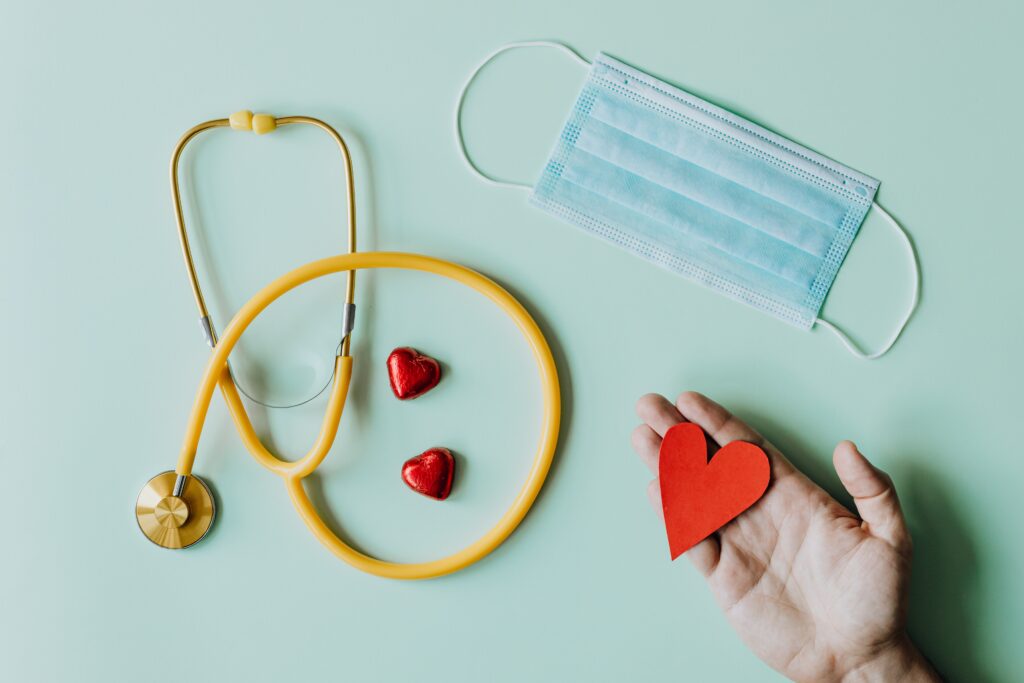Table of Contents
Introduction-What is Myocardial Infarction?
Myocardial infarction, commonly known as a heart attack, is a condition that occurs when blood flow to part of the heart muscle is suddenly blocked. The blockage is usually caused by a blood clot forming in one of the coronary arteries that supply oxygenated blood to the heart.
The most common cause of heart attack is atherosclerosis, a disease in which fat, cholesterol, and other substances build up and form plaques in the arteries. A rupture of one of the plaques can cause a blood clot that clogs the arteries and reduces blood flow to the heart muscle.

When the blood flow is too tight or completely blocked, the effect of the muscle is oxygen and nutrient starvation. If blood flow is not provided on time, the heart muscle begins to die and causes irreversible damage.
Causes of Myocardial Infarction
The main cause of most myocardial infarctions is atherosclerosis, a disease caused by the formation of fat, cholesterol, and other products of the arteries. These deposits gradually form plaques that can narrow and block blood flow in the arteries, reducing oxygen and nutrients to the heart muscle. Many things can cause atherosclerosis, which can lead to myocardial infarction:
High cholesterol: Increased levels of low-density lipoprotein (LDL) cholesterol (often called “bad cholesterol”) can cause plaques in the arteries.
High blood pressure (high blood pressure): Long-term high blood pressure can damage the arteries, causing more plaque to form in them.
Smoking: Smoking damages blood vessels, causes the development of atherosclerosis, and increases the risk of heart attack.
Diabetes: People with diabetes are more likely to develop atherosclerosis, which causes damage to the arteries due to high blood sugar levels.
Obesity: Being overweight and living a sedentary lifestyle can increase many risk factors for heart disease, such as high blood pressure, diabetes, and high cholesterol levels.
Family History: Having a family history of heart disease and myocardial infarction increases the risk of developing these diseases.
Age and gender: The risk of heart attack increases with age and is generally higher in men than in premenopausal women. But after menopause, a woman’s risk of heart attack increases significantly.
Stress: Chronic stress and anxiety can lead to heart disease in several ways, including increased blood pressure and unhealthy behaviors.
What Happens During in Myocardial Infarction?
During a myocardial infarction (commonly known as a heart attack), blood flow to part of the heart muscle is suddenly cut off, causing damage to heart tissue or death. This is due to a blockage of one of the coronary arteries that supply oxygen-rich blood to the heart.
Step-by-step analysis of what happens during a heart attack?
Plaque formation: Over time, fat, cholesterol, and other substances build up in the arteries of the arteries, forming plaque. This process is called atherosclerosis.
Rupture or blood clot: Sometimes the plaque in the artery wall can rupture, causing a blood clot at the rupture site. Blood clots can also form due to the presence of platelets on the surface of the plaque.
blockage of Artery: A blood clot can partially or completely block an artery, limiting or blocking blood flow to certain areas of the heart muscle.
Ischemia: Due to the low blood flow, the effect of the heart muscle does not receive enough oxygen and nutrients, causing ischemia (blood deficiency). This can cause chest pain or discomfort known as angina.
Infarction: If the blockage continues, the heart muscle begins to die from a lack of oxygen and nutrients. The death of the brain is called a myocardial infarction or simply a heart attack.
Inflammatory response: After a heart attack, the body initiates an inflammatory response in which the immune system sends cells to the damaged area to remove dead tissue and begin healing.
Scar tissue formation: As the healing process progresses, the dead tissue is replaced by scar tissue. However, scars do not have the same functional properties as healthy muscles, which can reduce the overall use of the heart.
The severity of a heart attack can vary depending on the size of the clogged artery, the location of the occlusion, and the speed of treatment. Prompt treatment is crucial to minimizing the damage from a heart attack and increasing your chances of survival and recovery. If you or someone else has symptoms of a heart attack, such as chest pain or discomfort, shortness of breath, or pain in the arms, back, neck, jaw, or abdomen, please see a doctor immediately.
Symptoms of Myocardial Infarction (Heart Attack)
Symptoms of myocardial infarction (heart attack) vary from person to person, and some people may have atypical or mild symptoms. Knowing the symptoms of a heart attack is important to get treatment quickly because prompt treatment can improve the outcome. Heart attack symptoms include:
Chest Pain or Discomfort: This is a sign of a heart attack. Pain is often described as a feeling of pressure, tightness, pressure, or heaviness in the chest. It will take a few minutes or it will come and go.
Pain elsewhere: Pain or discomfort may radiate to the arm (usually the right arm, but can affect both hands), back, neck, jaw, or abdomen. Some people may feel pain in these areas without discomfort in the chest.
Shortness of Breath: During a heart attack, you feel short of breath or short of breath, often chest pain.
Cold Sweat: You may feel cold, damp sweat even if the temperature is not cold.
Nausea and Vomiting: Some people may experience nausea or vomiting during cardiac arrest.
Dizziness or lightheadedness: Dizziness or lightheadedness can be a sign of a heart attack.
Fatigue: Weak fatigue or extreme tiredness can be a warning sign of a heart attack, especially for women.
It is important to remember that not everyone who has had a heart attack will have all of these symptoms, and some people may have only mild symptoms. In addition, some people, particularly women, the elderly, and people with diabetes, may have symptoms such as:
Unexplained or very tired
Upper back, shoulder, or jaw
Neck or throat abnormality or unexplained discomfort
Abdominal pain or Discomfort
A heart attack should be treated immediately by calling an ambulance (e.g., 911 in the United States) without delay if you suspect that you or someone else is suffering from one. Early diagnosis and treatment can be life-saving and prevent or minimize heart muscle damage.
Treatment of Myocardial Infarction (MI)?
Treatment of myocardial infarction (MI), commonly known as a heart attack, is time-sensitive and requires a combination of immediate treatment and long-term management. The main goals of treatment are to restore blood flow to the heart muscle, prevent further damage and reduce the risk of complications.

The following are important aspects of myocardial infarction treatment:
1-Emergency treatment: If a person has symptoms of a heart attack such as chest pain, shortness of breath, nausea, or dizziness, it is important to seek medical attention immediately. Call an ambulance without delay.
2-Initial assessment: Upon arrival at the hospital, the healthcare team will conduct an overall assessment.
troponin levels) and visual studies (eg, echocardiogram).
3-Oxygen Therapy: Oxygen can be given to increase the amount of oxygen going to the heart and body.4-Medications: Many medications are often used to treat MI, including:
- Thrombolytics or fibrinolytics: These medications break up blood clots and increase blood flow to the heart. They are most effective when given as early as possible within a certain period after the onset of symptoms.
- Antiplatelet medications: Medications such as aspirin and clopidogrel help prevent more blood clots from forming.
- Anticoagulants: Drugs such as heparin or enoxaparin are used to prevent blood clotting.
- Painkillers: Pain relievers such as nitroglycerin and morphine can relieve chest pain.
- Beta-blockers: Slow the heart and lower our high blood pressure.
- ACE inhibitors or ARBs: These drugs are used to heal the heart and prevent the heart muscle from remodeling.
- Statins: Cholesterol-lowering drugs that help control plaque in the arteries.
5-Reperfusion Therapy: It is important to restore blood flow to clogged arteries to minimize myocardial damage. Reperfusion can be achieved in two main ways:
- Percutaneous Coronary Intervention (PCI): This is the preferred method if available and may include balloon angioplasty and stent placement to open the artery.
- Coronary artery bypass grafting (CABG): If PCI is not an option, CABG surgery may be considered in some patients.
6-Cardiac Rehabilitation: After initial therapy and stabilization, patients are often advised to participate in cardiac rehabilitation. These services include exercise supervision, emotional modification training, and emotional support.
7-Long-Term Management: Risk management is important to prevent future heart problems. This can include lifestyle changes such as adopting a healthy heart, exercising regularly, quitting smoking, and using appropriate medications to manage conditions such as high blood pressure, diabetes, and high cholesterol.
Remember that the treatment of myocardial infarction is specific and individual and should be treated according to the patient and the patient’s history. Early diagnosis and timely treatment can increase the chances of a successful outcome. Get medical help right away if you or someone else has symptoms of a heart attack.
Summary
Myocardial infarction, popularly known as a heart attack, is a serious condition that occurs when blood flow to a part of the heart stops and causes the death of the muscle. It is usually caused by a sudden and complete blockage of one of the coronary arteries that supply oxygen and nutrients to the heart


[…] Medication Complication: If your doctor has given you medication for conditions such as high blood pressure or high cholesterol, take it as needed, and do not stop or adjust your medication without consulting your doctor. […]